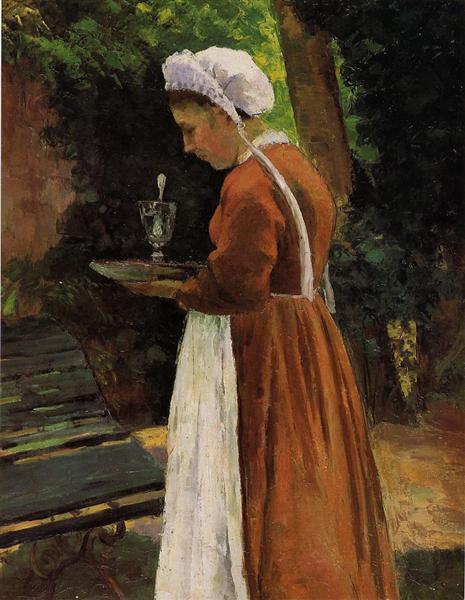Description
In Camille Pissarro's "The Servant", a work dated 1875, we are presented with a scene that denounces, through its particular visual treatment, the social dynamics of the time, as well as the place of women in the society of that time. Pissarro, one of the founders of the impressionist movement, portrays here a young woman, probably a servant, with an approach that goes beyond the simple portrait. This figure, enveloped in an atmosphere of everyday life, becomes the center of attention in a composition that prioritizes everyday life and realism.
The servant is shown in profile, allowing the viewer to appreciate the firmness of her posture and the concentration of her gaze on an unspecified task, giving herself over to servitude without comment or embellishment. The choice of earthy colours in her clothing suggests the shadows of daily life and the humility of her existence, while the surfaces painted with loose brushstrokes give the work an air of improvisation, characteristic of the Impressionist style. This use of colour and technique not only frames the central figure, but also suggests an almost symbolic importance of the return to the everyday.
Looking at the painting's richly textured and nuanced background, one perceives a number of elements that, although not precisely defined, contribute to the creation of an intimate and personal atmosphere. The softly filtering light indicates the time of day, creating an effect that enhances the three-dimensionality of the figure and brings to life the space it occupies. The attention to the effect of light on the maid's skin, as well as on the surrounding surfaces, reveals Pissarro's interest in the interplay between light and colour, a hallmark of Impressionism.
Pissarro not only portrays the figure of the servant, but also invites us to reflect on the social context of women in the 19th century. The work of servants was typically carried out in the domestic sphere, a world often rendered invisible by the artistic narrative of the time; Pissarro, however, chooses to give voice to this representation. Through his approach, the artist challenges the notions of bourgeois art that used to choose to glorify the female figure from an idealized prism, and instead, delves into the everyday.
When reflecting on The Servant, it is pertinent to place the work in the context of Pissarro's other paintings. His Impressionist contemporaries, such as Claude Monet and Pierre-Auguste Renoir, often explored light and nature in their works. However, Pissarro is distinguished by his ability to capture the human, the ordinary moments, stripped of idealization and filled with truth. This work, with its strong symbolic charge and exceptional technique, is a testament to the author's quest to represent social reality with an intimate approach.
Finally, The Servant opens a dialogue with the viewer about the relationship between class, gender and representation, inviting a deep reflection on the lives of those not represented in art. Through his palette and technique, Pissarro manages not only to document a moment in time, but also to elevate everyday life into an art form worthy of contemplation, turning the seemingly mundane into an object of reflection. This work, therefore, is not just a portrait of a woman in her work environment, but a statement about the human condition, a revelation that continues to resonate in contemporary artistic discourse.
KUADROS ©, a famous painting on your wall.
Hand-made oil painting reproductions, with the quality of professional artists and the distinctive seal of KUADROS ©.
Painting reproduction service with satisfaction guarantee. If you are not completely satisfied with the replica of your painting, we will refund 100% of your money.

